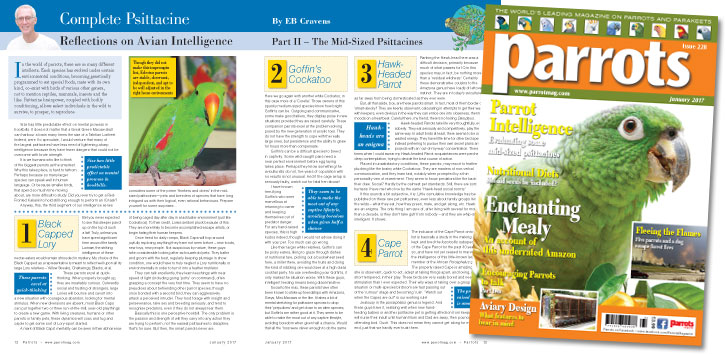
Complete Psittacine by Eb Cravens
In the world of parrots, there are so many different intellects. Each species has evolved under certain environmental conditions, becoming genetically programmed to eat special foods, mate with its own kind, co-exist with birds of various other genera, not to mention reptiles, mammals, insects and the like. Psittacine brainpower, coupled with bodily conditioning, allows select individuals in the wild to survive, to prosper, to reproduce.
Size has little predictable effect on mental prowess in hookbills. It does not matter that a Great Green Macaw skull can harbour a brain many times the size of a Tahitian Lorikeet. Indeed, were I to speculate, I would venture that many of the largest psittacines have less need of lightening-sharp intelligence because they have fewer dangers that could not be overcome with brute strength.
Buy Now!
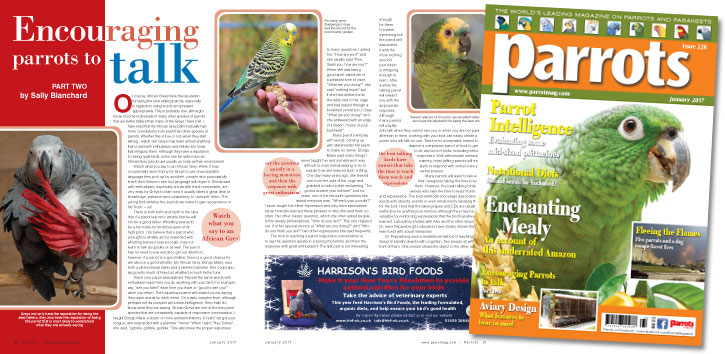
by Sally Blanchard
Of course, African Greys have the reputation for being the best talking parrots, especially in regards to using words and phrases appropriately. This is probably true, although I know of some individuals of many other species of parrots that are better talkers than many of the Greys I have met. I have read that the African Grey parrot actually has more convolutions in its brain than other species of parrots. Whether this is true or not, when they start talking - watch out! Greys may learn almost anything that is said with enthusiasm and imitate any noise that intrigues them. Although they have a reputation for being quiet birds, some can be quite noisy as African Grey parrots are usually as noisy as their environment.
Watch what you say to an African Grey. While it may occasionally seem funny for Greys to use unacceptable language they pick up by accident, people who purposefully teach their Greys to use foul language will regret it. Words said with enthusiasm, especially words with hard consonants, are very easy for Greys to learn and it usually takes a great deal of knowledge, patience and consistency to ‘unteach’ them. The young bird imitates the sounds we make to gain acceptance in his ‘flock’ – us!
Buy Now!
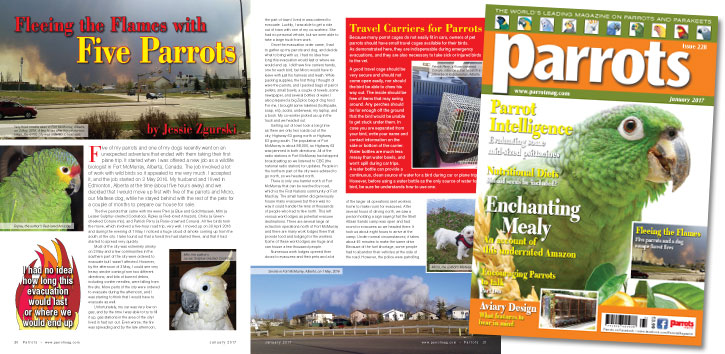
by Jessie Zgurski
Five of my parrots and one of my dogs recently went on an unexpected adventure that ended with them taking their first plane trip. It started when I was offered a new job as a wildlife biologist in Fort McMurray, Alberta, Canada. The job involved a lot of work with wild birds so it appealed to me very much. I accepted it, and the job started on 2 May 2016. My husband and I lived in Edmonton, Alberta at the time (about five hours away) and we decided that I would move up first with five of the parrots and Micro, our Maltese dog, while he stayed behind with the rest of the pets for a couple of months to prepare our house for sale.
The five parrots that came with me were Pteri (a Blue and Gold Macaw), Mitri (a Lesser Sulphur-crested Cockatoo), Ripley (a Red-lored Amazon), Chiku (a Green-cheeked Conure mix), and Patrick Perry (a Rose-crowned Conure). All five birds took the move, which involved a five-hour road trip, very well. I moved up on 30 April 2016 and during the evening of 1 May, I noticed a huge cloud of smoke coming up from the south of the city. I later found out that a forest fire had started there, and that it had started to spread very quickly.
Buy Now!
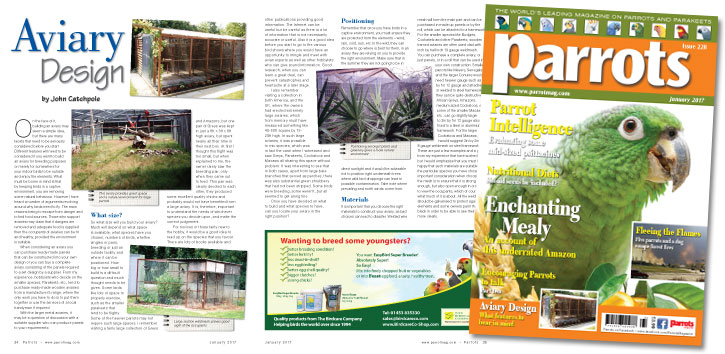
by John Catchpole
On the face of it, building an aviary may seem a simple idea, but there are many facets that need to be seriously considered before you start. Different features will need to be considered if you want to build an aviary for breeding purposes or merely for somewhere for your indoor birds to be outside and enjoy the elements. What must be borne in mind is that by keeping birds in a captive environment, you are removing some natural behaviour. However I have heard a number of arguments revolving around why birds need to fly. The main reasons being to escape from danger and to find food sources. Those who support aviaries may claim that if dangers are removed and adequate food is supplied then the occupants of aviaries can be fit and healthy, provided the environment is suitable.
When considering an aviary you can purchase ready-made panels that can be constructed into your own design or you can buy a complete aviary consisting of the panels required to a set design by a supplier. From my experience, hobbyists who decide on the smaller species, Parakeets, etc., tend to purchase ready-made wooden aviaries from a manufacturer’s range, where the only work you have to do is to put them together or use the services of a local handyman if required.
Buy Now!
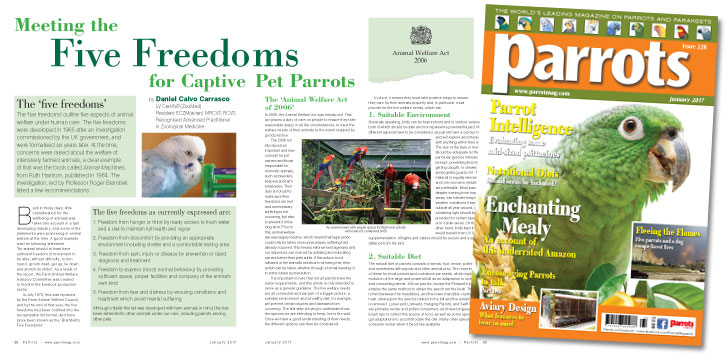
by �Daniel Calvo Carrasco
The 'five freedoms' outline five aspects of animal welfare under human care. The five freedoms were developed in 1965 after an investigation commissioned by the UK government, and were formalised six years later. At the time, concerns were raised about the welfare of intensively farmed animals, a clear example of that was the book called Animal Machines, from Ruth Harrison, published in 1964. The investigation, led by Professor Roger Brambell, listed a few recommendations.
Back in those days, little consideration for the wellbeing of animals was taken into account in a fast developing industry, and some of the statements were pioneering in animal welfare at the time. A good example was the following statement:
"An animal should at least have sufficient freedom of movement to be able, without difficulty, to turn round, groom itself, get up, lie down and stretch its limbs". As a result of the report, the Farm Animal Welfare Advisory Committee was created to monitor the livestock production sector.
Buy Now!





